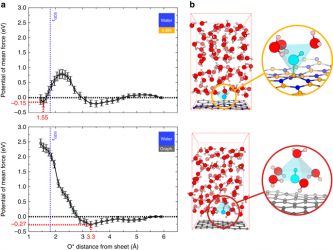
The recent emergence of nanofluidics has highlighted the exceptional properties of graphene and its boron-nitride counterpart as confining nanomaterials for water and ion transport. Surprisingly, ionic transport experiments have unveiled a consequent electrification of the water/carbon surfaces, with a contrasting response for its water/boron-nitride homologue. In this paper, we report free energy calculations based on ab initio molecular dynamics simulations of hydroxide OH− ions in water near graphene and hexagonal boron nitride (h-BN) layers. Our results disclose that both surfaces get charged through hydroxide adsorption, but two strongly different mechanisms are evidenced. The hydroxide species shows weak physisorption on the graphene surface while it exhibits also strong chemisorption on the h-BN surface. Interestingly OH− is shown to keep very fast lateral dynamics and interfacial mobility within the physisorbed layer on graphene. Taking into account the large ionic surface conductivity, an analytic transport model allows to reproduce quantitatively the experimental data.

N’hésitez pas à consulter le communiqué de presse associé à cet article : Graphène et Bore-Azote hexagonal : des faux-jumeaux innovants pour produire l’énergie bleue !
References:
Versatile Electrification of Two-dimensional Nanomaterials in Water
Benoît Grosjean, Marie-Laure Bocquet, and Rodolphe Vuilleumier
Nature Communications 10,1656 (2019)
DOI: 10.1038/s41467-019-09708-7
Versatile Electrification of Two-dimensional Nanomaterials in Water
